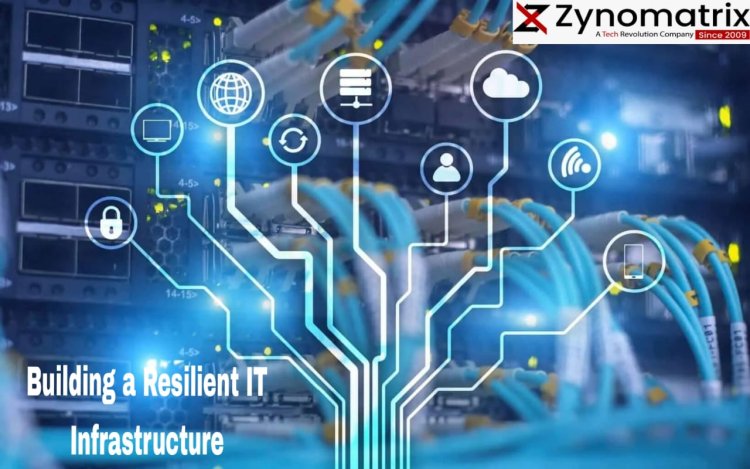Building a Resilient IT Infrastructure: Strategies for Disaster Recovery and Business Continuity
In this blog post, we will explore the strategies and best practices for building a resilient IT infrastructure that can effectively respond to and recover from disasters. We will begin by emphasizing the importance of conducting a comprehensive risk assessment to identify potential risks and vulnerabilities within the IT infrastructure. Next, we will delve into the development of a disaster recovery plan, which includes essential components such as data backup and recovery procedures, high-availability architecture, establishing a disaster recovery site, and conducting regular testing to validate the effectiveness of the plan. We will then shift our focus to business continuity measures, highlighting the significance of conducting a business impact analysis to identify critical processes and establish recovery objectives. We will discuss the implementation of redundant infrastructure, incident response planning, and enabling employees with the necessary tools and resources to ensure

Introduction:
In today's interconnected and technology-dependent business landscape, building a resilient IT infrastructure is crucial for ensuring the continuity of operations and mitigating the impact of unforeseen disasters. Disruptions can arise from various sources, including natural disasters, cyberattacks, equipment failures, or human error. To safeguard critical systems, data, and processes, organizations must implement robust disaster recovery (DR) and business continuity (BC) strategies. In this blog post, we will explore key strategies for building a resilient IT infrastructure that can effectively respond to and recover from disasters.
Conduct a Risk Assessment:
Before implementing any disaster recovery or business continuity plan, it is essential to conduct a comprehensive risk assessment. This assessment should identify potential risks, vulnerabilities, and critical assets within the IT infrastructure. Understanding the potential impact of different scenarios will help prioritize efforts and allocate resources accordingly.
Develop a Disaster Recovery Plan:
A disaster recovery plan outlines the steps and procedures to recover critical systems, applications, and data following a disruptive event. Key components of a robust DR plan include:
- Data Backup and Recovery: Implement regular, automated backups of critical data and establish backup retention policies. Employ both onsite and offsite backups to ensure data redundancy and protection against localized incidents. Test the restoration process periodically to validate the backup's integrity and reliability.
- High-Availability Architecture: Design the IT infrastructure with redundancy and fault-tolerant configurations. This may involve using redundant servers, network devices, and storage systems to minimize single points of failure. Employ technologies like load balancing, clustering, and virtualization to ensure high availability and seamless failover.
- Disaster Recovery Site: Establish an offsite location or data center that can serve as a backup site in the event of a disaster. This site should have sufficient hardware, network connectivity, and power infrastructure to support critical operations. Regularly test the site's readiness and the procedures for activating it in case of a disaster.
- Disaster Recovery Testing: Conduct regular testing and simulations of the disaster recovery plan to identify gaps, validate recovery time objectives (RTOs), and train staff on their roles and responsibilities during a recovery scenario. Testing helps uncover potential issues and ensures that the DR plan remains effective and up to date.
Implement Business Continuity Measures:
Business continuity planning focuses on maintaining essential business functions during and after a disruption. It involves:
- Business Impact Analysis: Identify critical business processes and determine their dependencies on IT systems. Assess the financial, operational, and reputational impacts of disruptions to prioritize recovery efforts. Develop recovery time objectives (RTOs) and recovery point objectives (RPOs) for each critical process.
- Redundant Infrastructure: Establish redundant systems, networks, and facilities to ensure continuous operations. This may include implementing failover mechanisms, utilizing cloud services, or maintaining secondary workspaces that can be quickly activated.
- Incident Response Plan: Develop an incident response plan that outlines the steps to be taken during a disruption, including communication protocols, responsibilities, and escalation procedures. Train employees on incident response and conduct drills to test their preparedness.
- Employee Enablement: Ensure employees have the necessary tools, resources, and access to continue their work during a disruption. Enable remote work capabilities and establish communication channels to facilitate collaboration and information sharing.
Regularly Update and Test the Plans:
Disaster recovery and business continuity plans should not be static documents. They require regular updates to reflect changes in the IT infrastructure, business processes, and emerging threats. Furthermore, testing and exercising the plans is essential to validate their effectiveness and identify areas for improvement. Regular plan reviews and updates, coupled with realistic testing, help maintain a state of readiness.
Plan Review and Updates:
Disaster recovery and business continuity plans should not be static documents. As your IT infrastructure, business processes, and potential risks evolve, it is essential to review and update these plans accordingly.
- Document Changes: Regularly document any changes in your IT infrastructure, such as hardware upgrades, software updates, or changes in network configurations. These changes should be reflected in your plans to ensure that recovery procedures align with the current state of your systems.
- Risk Assessment Updates: Conduct periodic risk assessments to identify new vulnerabilities and potential risks. Incorporate the findings of these assessments into your plans to address emerging threats effectively.
- Business Process Changes: As your business evolves, processes may change or new critical processes may emerge. Review and update your plans to reflect these changes and ensure that recovery priorities and objectives align with the current state of your organization.
- Stakeholder Input: Involve key stakeholders, including IT personnel, department heads, and senior management, in the plan review process. Their insights and feedback can help identify areas for improvement and ensure that the plans remain relevant and aligned with organizational goals.
What's Your Reaction?





















